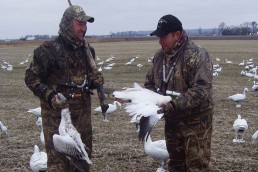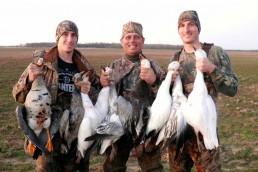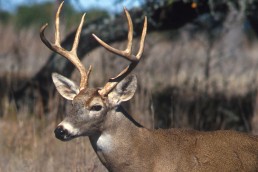Southern Waterfowl Hunters are Adapting
SHARE THIS POST
In recent years, southern waterfowl hunters have made changes in how they pursue birds. Birds hunted in the South are a migratory flock with much fewer resident birds.
As a rule, up until 2012, many of the Canada geese were short-stopping in response to the milder winters to the north. Local hunters and goose clubs changed to a duck habitat to attract ducks during an absence of geese. Ducks and snow geese were going on down further to the south. In 2013, numerous specklebelly geese and increasing numbers of snow geese which had been rare sights in the past began to be more common sights.
In response to these changes, hunters often moved from traditional open-field goose hunting areas to river bottoms. Snow geese like the duck habitat often found there. They like the farm crop fields, sloughs, flooded fields and shallow water. Hunting more ducks, snow geese and white fronted geese known locally as specklebellys became the norm in many areas. Hunters have had to adapt their approaches.
Hunters still utilize both pits and ground blinds. They also use duck blinds in the sloughs and on rivers. Blinds work well around buck brush and are placed up on stilts in areas likely to flood.
On higher land, pits are still popular because it is easier to remain concealed in a pit than it is in a blind. Hunting open fields continues to be successful. Waterfowl hunters set up on the top edge of an open draw where they might put up a little levee and have a little sheet water in crops. Once the landowners finish harvesting the crops, hunters can add sheet water. Many clubs have most of their pits in locations where they have water around them.
Some hunters have gone to more specklebelly and white geese decoys. The duck spreads have pretty much stayed the same. Most still contain a considerable number of Canada decoys. In the past, specklebelly decoys were never an option.
As more and more specks move into an area, more decoys become popular. By strategic use of trolling motors, one creates a little bit of ripple on the water. The supplementing of them with motion duck decoys presents a more realistic appearance. You can put a dozen decoys right in front of a trolling motor and they will swim from side to side. On calm days, it makes a ripple on the water.
With a freeze, a trolling motor keeps the water from freezing up. It keeps an open hole in the ice. The water may freeze overnight. In the morning, hunters break a hole and install a trolling motor. In a few minutes it becomes a 20- to 30-foot circle of open water. By packing the decoys tight together, it looks like they are sleeping and resting around the edges.
Are you enjoying this post?
You can be among the first to get the latest info on where to go, what to use and how to use it!
In the late ‘90s, the once-popular flute goose calls gave way to short reed calls for Canadas. Hunters have learned to use specklebelly calls. The migrating ducks hear so much of traditional duck calls that hunters are replacing them with pintail whistles. Also popular are gadwall calls and widgeon whistles—anything that sounds different from the regular mallard hen call they hear in every duck blind up and down the flyway.
It is surprising how well a goose call will work on a flock of mallards simply because it is something different. It is something they hear daily in the refuges, it sounds familiar to them but it is not what they hear coming out of every blind they fly over.
As more ducks pack in with the geese, they know geese will keep the water open and that the geese will find food. The mallards, gadwalls and widgeon will follow those geese out to dry field feed just like a goose.
Become a MidWest Outdoors Insider here!
MWO
SHARE THIS POST
Did you enjoy this post?
You can be among the first to get the latest info on where to go, what to use and how to use it!
Don Gasaway
Don Gasaway is a veteran freelance outdoor writer from Marion, Ill. He may also be found at: https://www.facebook.com/DonGasawayWriter and facebook.com/Wandering Angler. Comments are welcome



